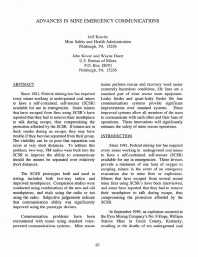Mining Publication: Advances in Mine Emergency Communications
Original creation date: April 1994
Since 1981, Federal mining law has required every miner working in underground coal mines to have a self-contained, self-rescuer (SCSR) available for use in emergencies. Some miners that have escaped from fires using SCSR's have reported that they had to remove their mouthpiece to talk during escape, thus compromising the protection afforded by the SCSR. If miners are in thick smoke during an escape, they may have trouble if they become separated from their group. The visibility can be so poor that separation can occur at very short distances. To address this problem, two-way, FM radios were built into the SCSR to improve the ability to communicate should the miners be separated over relatively short distances. The SCSR prototypes built and used in testing included both two-way radios and improved mouthpieces. Comparison studies were conducted using combinations of the new and old mouthpieces, and trials using the radio or not using the radio. Subjective judgements indicate that communication ability was significantly improved using the prototype devices. Communication problems have been encountered with teams using standard voice-powered communications systems. Mine rescue teams perform rescue and recovery work under extremely hazardous conditions, life lines are a standard part of mine rescue team equipment. Leaky feeder and quasi-leaky feeder life line communications systems provide significant improvements over standard systems. These improved systems allow all members of the team to communicate with each other and their base of operations. These innovations will significantly enhance the safety of mine rescue operations.
Authors: JH Kravitz, JG Kovac, WH Duerr
Conference Paper - April 1994
NIOSHTIC2 Number: 10005429
TIEMEC '94. The International Emergency Management and Engineering Conference, April 18-21, 1994, Hollywood Beach, Florida. Sullivan JD, and Tufekci S, eds., Dallas, TX: The International Emergency Management and Engineering Society, 1994 Apr; :23-26
See Also
- 3+3 SCSR Donning Screen Saver - 1.0
- Advanced Tutorial on Wireless Communication and Electronic Tracking: Introduction
- The Emergency Communication Triangle
- Passive Fiber Optic System for Locating, Tracking, and Communicating with Personnel in Coal Mines
- Performance and Safety Investigation of Emergency Backup Batteries and Battery Charging Systems for Underground Mining Applications
- Radio 101: Operating Two-Way Radios Every Day and in Emergencies
- Self-Contained Self-Rescuer Donning Proficiency at Eight Eastern Underground Coal Mines
- Technology News 507 - NIOSH Safety Talk: The Emergency Communication Triangle
- Technology News 543 - Reverse Implementation of Radio Frequency Identification (RFID) Technology for Personnel Tracking in Underground Mines
- Two-Way, Through-the-Earth Emergency Communication System for Trapped Miners and the Surface
- Page last reviewed: 9/21/2012
- Page last updated: 9/21/2012
- Content source: National Institute for Occupational Safety and Health, Mining Program


 ShareCompartir
ShareCompartir
